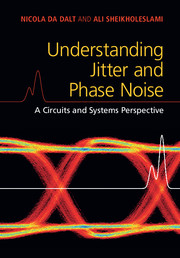Book contents
- Frontmatter
- Dedication
- Contents
- Preface
- Acknowledgments
- 1 Introduction to Jitter
- 2 Basics of Jitter
- 3 Jitter and Phase Noise
- 4 Jitter and Phase Noise in Circuits
- 5 Effects of Jitter in Synchronous Digital Circuits
- 6 Effects of Jitter on Data Converters
- 7 Effects of Jitter in Wireline Applications
- 8 Phase Noise in Wireless Applications
- 9 Advanced Concepts on Jitter and Phase Noise
- 10 Numerical Methods
- Appendix A Review of Random Variables and Processes
- Appendix B Matlab Code for Jitter Generation and Analysis
- Bibliography
- Index
Appendix A - Review of Random Variables and Processes
Published online by Cambridge University Press: 19 February 2018
- Frontmatter
- Dedication
- Contents
- Preface
- Acknowledgments
- 1 Introduction to Jitter
- 2 Basics of Jitter
- 3 Jitter and Phase Noise
- 4 Jitter and Phase Noise in Circuits
- 5 Effects of Jitter in Synchronous Digital Circuits
- 6 Effects of Jitter on Data Converters
- 7 Effects of Jitter in Wireline Applications
- 8 Phase Noise in Wireless Applications
- 9 Advanced Concepts on Jitter and Phase Noise
- 10 Numerical Methods
- Appendix A Review of Random Variables and Processes
- Appendix B Matlab Code for Jitter Generation and Analysis
- Bibliography
- Index
Summary
This appendix reviews in a very compact form the basic concepts of random variables and random processes for the purpose of understanding jitter and phase noise. The goal is not to provide a thorough treatment, but rather to help the reader in recalling the definitions and the meanings of some of the most useful and common concepts. It is assumed that the reader is familiar with the basic concepts of probability. Although not strictly necessary, it is beneficial that the reader has been previously exposed to the theory of random variables and random processes, as can be found in a typical graduate university class. For further reading, or an in-depth analysis of the concepts, such specialized textbooks as [1], [13], [129], and [105] can be consulted.
Random Variables
Definition
Given an experiment with many possible outcomes, a random variable X is defined as a function that assigns a real number to each outcome of this experiment. In order to be called a random variable, the function must satisfy the following condition: the set of outcomes for which X is smaller than or equal to a given real number a, has a given, well-defined probability for any a.
As an example, let's take as an experiment the toss of a dice. The possible outcomes are each of the six faces of the dice. We can associate with each face the integer numbers 1 to 6, even if there are no numbers (or dots) on the faces of the dice (assuming that we can distinguish each of the faces of the dice somehow). This rule of association can be formalized as a function X which can assume the values 1, 2, 3, 4, 5, 6. Given any real number a, the probability that X < a is always well defined. For instance, the probability that X ≤ 3.4567 is equal to the probability that the dice shows one of the faces associated with the numbers 1 to 3. The probability that X ≤ -1 is obviously zero, since there is no possible outcome associated to numbers below 1. Since the condition stated in the above paragraph is satisfied, X can be called a random variable.
Note that the name “random variable” is, strictly speaking, a misnomer, since it refers to a function, not to a variable.
Information
- Type
- Chapter
- Information
- Understanding Jitter and Phase NoiseA Circuits and Systems Perspective, pp. 220 - 232Publisher: Cambridge University PressPrint publication year: 2018
